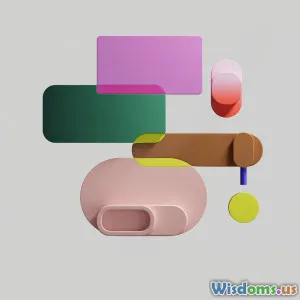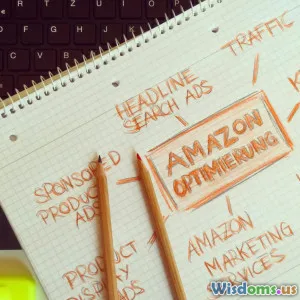
The Impact of Technology on Graphic Design
7 min read Explore how technological advancements revolutionize graphic design, enhancing creativity and efficiency in remarkable ways. (0 Reviews)
The Impact of Technology on Graphic Design
Graphic design, once rooted in manual sketches and physical media, has undergone a staggering transformation thanks to rapid technological advancements. From the introduction of digital tools to the rise of artificial intelligence, technology has fundamentally reshaped how creative minds visualize and execute designs. This shift not only streamlines workflows but also expands the boundaries of what designers can imagine and create.
Introduction: Bridging Art and Digital Innovation
Picture a time when graphic designers used scissors, glue, and airbrushes as primary tools. Today, the landscape is radically different—designers harness powerful software, tablets, and AI-powered platforms to drive innovation. This fusion of technology with artistic creativity offers new freedom and challenges, redefining the essence of graphic design itself. Why should creatives care about the technological wave? Because understanding it unlocks unmatched creative potential and career relevance in an ever-evolving industry.
Digital Tools: Revolutionizing the Designer’s Palette
The Dawn of Graphic Design Software
Adobe Photoshop, Illustrator, and InDesign are now household names—tools that have transformed design from analog to vibrant digital expression. Photoshop, launched in the late 1980s, pioneered pixel-based image editing allowing designers unprecedented control. Illustrator introduced scalable vector graphics enabling flexible resizing without quality loss, essential for logos and branding.
Today, the Adobe Creative Cloud ecosystem empowers designers to share and collaborate in real-time, fostering increased productivity. Figma and Sketch emphasize web-based, collaborative design, breaking down geographic barriers even further.
Tablets and Styluses: Bringing Back the Handcrafted Feel
Even as digital software dominates, devices like the Wacom tablet and Apple Pencil have resurrected the tactile connection between creator and canvas. These tools enable precise brushstrokes and annotations, preserving the artist’s touch within digital mediums. For example, artists working in digital illustration or concept art rely on pressure sensitivity and tilt recognition, features impossible without these innovations.
Artificial Intelligence: Shaping the Future of Creativity
AI as a Collaborative Partner
Artificial intelligence tools have quickly made their mark in graphic design workflows. Platforms like Adobe Sensei or Canva’s design suggestions leverage machine learning to automate repetitive tasks such as color palette generation or layout arrangement.
AI-powered image recognition can suggest themes or styles, sparing designers hours of tedious work. In some cases, AI generates entire design drafts based on minimal input, pushing the boundaries of what’s possible.
Ethical and Creative Considerations
Despite AI’s advantages, it raises critical questions on authorship and originality—does the AI influence dilute the artist’s personal touch, or is it simply another advanced tool? As AI democratizes design, enabling novices to produce polished work, the roles of professional designers evolve towards strategy, storytelling, and curation.
Collaboration and Remote Work Enabled by Technology
Cloud Platforms and Real-Time Editing
The rise of cloud computing has revolutionized how design teams operate. Tools like Adobe Creative Cloud, Figma, and Google Drive facilitate real-time feedback and version control. For instance, design teams split across continents can simultaneously work on the same file, enabling a seamless creative dialogue.
Democratizing Design with Accessible Platforms
DIY design websites such as Canva and Crello make graphic design accessible to entrepreneurs and hobbyists without formal training. This enlarges the design community but also challenges professionals to offer increasingly complex, nuanced outputs to stay competitive.
Data-Driven Design and Personalization
Technology also feeds data into the creative process. Analytics and user feedback inform design decisions, allowing more personalized and effective visual communication.
For example, A/B testing multiple banner designs online empowers marketers and designers to optimize visuals for increased engagement. This shift toward responsive and adaptive design ensures that content resonates with target audiences dynamically.
Challenges: Technology’s Double-Edged Sword
While technology delivers remarkable tools, it also introduces complexities. Keeping pace with frequent updates demands continuous learning. Graphic design software can be costly, posing barriers for freelancers or small businesses.
Moreover, over-reliance on templates or AI-generated designs risks homogenizing creativity. Designers must balance efficiency with innovation, preserving the authentic artistic vision amid technological convenience.
Conclusion: Embracing Technology to Elevate Creativity
The impact of technology on graphic design transcends tools; it reshapes mindsets and methodologies. Digital innovation expands creative possibilities, enabling designers to craft richer, more engaging visuals while streamlining workflows.
As technology continues evolving, graphic designers who embrace its potential, remain adaptable, and pursue continual learning will thrive. Ultimately, technology is not replacing creativity—it is amplifying the boundless human capacity to imagine, inspire, and communicate visually.
"Technology over technique produces emotionless design." — Daniel Mall
Understanding this balance ensures technology empowers, rather than diminishes, the core of graphic design: creative human expression.
References:
- Adobe Creative Cloud Stats (Adobe.com)
- "The History of Graphic Design Software" – Creative Bloq
- Deloitte’s 2023 Design Trends Report
- Canva User Growth Data (Statista)
- "Artificial Intelligence in Design: Boon or Bane?" – Journal of Design Technology
Rate the Post
User Reviews
Popular Posts





















